An insider's guide to San Francisco's seven best locals-only gems
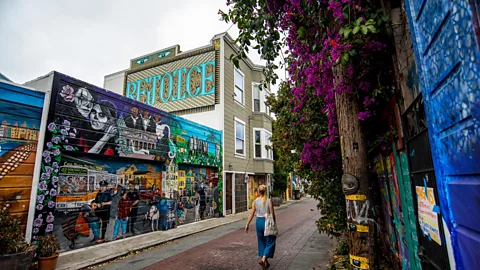 Andrew Lloyd/Alamy
Andrew Lloyd/AlamyFrom rambling up the Saturn Steps to dipping into El Rio for a drink to eating your way through the Mission, local expert Laura Kiniry shares her only-in-SF picks.
Sure, the Golden Gate Bridge is iconic and climbing the hills in a cable car is practically a rite of passage, but San Francisco, California, has plenty of more obscure attractions that are typically overlooked. This is a city loaded with fascinating history, from its days as a booming Gold Rush centre to its role as an epicentre of gay rights. Its "anything-goes" attitude has long attracted dreamers, creatives and travellers.
It's also a city of neighbourhoods, where you might find yourself dining on bursting-at-the-seams burritos in the company of a mariachi band in the Mission District one hour, and across town trying your hand at origami in Japantown the next. Experiences like these embody the heart of San Francisco and offer real insight into the diversity, culture and people that make the city so special. They're not things easily found at tourist-heavy spots like Fisherman's Wharf or a walk around Union Square, but once you know where to look, you can start peeling back the layers that make San Francisco so utterly and undeniably one-of-a-kind.
From strolling through urban jungles in the midst of wild parrots to dancing away an afternoon on the back patio of an LGBTQ+ institution, here are seven only-in-SF must-do experiences.
 Laura Kiniry
Laura Kiniry1. Best for history: Presidio National Park
History exudes from nearly every inch of this 6.2-sq-km parkland that's perched at the southern foot of the Golden Gate Bridge. The Muwekma Ohlone people occupied the land that's now the Presidio for centuries before Spain established it as a military base in 1776 – one that Mexico, and later the US, took over. Congress closed the base in 1989 and by 1994 it became a part of the US National Park Service.
Today the Presidio is a natural and cultural playground for city residents, drawn by its windy roads that are ideal for cycling and hiking and meander among towering cypress, pine and eucalyptus trees. Former officers' quarters and army barracks have been transformed into boutique lodgings and museums highlighting the life of Walt Disney and Golden Gate Park during the Gilded Age. There's even a converted air hanger that houses an indoor trampoline park.
One of the Presidio's newest additions is its Presidio Tunnel Tops, a 14-acre oasis spread atop two highway tunnels that have replaced a stretch of road irreparably damaged by a 1989 earthquake. Along with a wind-sheltered campfire circle and huge play structures crafted from fallen trees and boulders, Tunnel Tops connects the bulk of the Presidio with its long-isolated Crissy Field, a former military runway that's now brimming with tidal marsh and spongy grasslands, along with unbeatable bayside views.
Website: www.presidio.gov/
Address: 210 Lincoln Boulevard, San Francisco
Phone: +1 415 561 4323
Instagram: @presidiosf
 Wikipedia
Wikipedia2. Best for a tipple: El Rio
What began as a gay leather bar in the late 1970s is now one of San Francisco's most beloved neighbourhood institutions. A sign hanging out front lovingly refers to it as "Your Dive" (a slogan that was actually part of its original name), and the LQBTQ+ space in the city's Outer Mission District attracts everyone from straight couples to gay tech bros. Locals flock to El Rio for regular events like Salsa Sundays (every fourth Sunday) and Drag Bingo nights, while queer artist showcases and all-female rock shows are also par for the course.
The SpeciaList
Journalist and San Francisco resident Laura Kiniry has lived in the heart of the city for nearly 30 years, and has been writing about her chosen home for more thana decade.
With its lemon and palm trees, strewn lights and a large wooden mural of actress and samba singer Carmen Miranda hanging as a backdrop, the bar's back patio is the place to be on warm nights. BYO food and settle at one of the scattering of tables for a meal, or partake in a seemingly endless dance party instead. The divey vibe indoors is perfect for sipping on mezcal margaritas and pints of draft-poured IPAs, or for playing a couple of games of shuffleboard.
El Rio considers itself a "work in progress" (for example, they're currently raising funds for more bathrooms), and its long-time fans are happily along for the ride.
Website: www.elriosf.com/
Address: 3158 Mission Street, San Francisco
Phone: +1 415 282 3325
Instagram: @elriosf
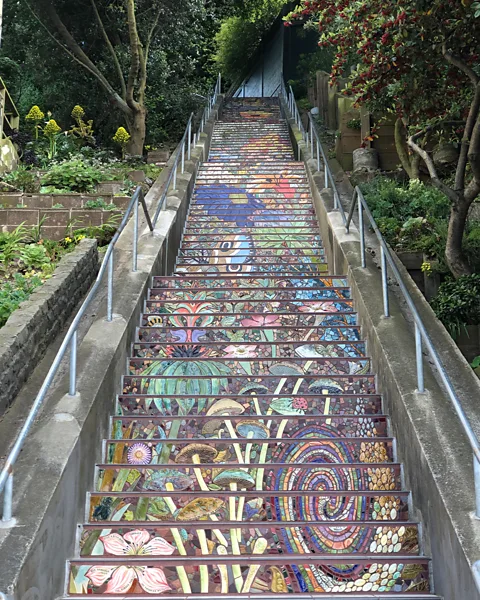 Laura Kiniry
Laura Kiniry3. Best for outdoor exercise: San Francisco staircases
San Francisco is a city of hills. Thankfully, this also means some incredible public staircases. The city literally has hundreds of them, many tucked away in residential neighbourhoods and hidden among overgrown urban jungles, accessible only on foot. Some are merely shortcuts, while others are lush green oases offering a quiet reprieve and resulting in some stellar skyline vistas.
Local residents especially love the Sunset neighbourhood's 16th Avenue Tiled stairway, a 163-step climb covered in a mosaic of sea and stars that leads to a small park filled with cypress trees and ancient rock formations.
Over in the Castro district, the Vulcan Steps stretch upwards for nearly two blocks, passing cosy-looking bungalows and terraced gardens, while a half-block away, the Saturn Steps happen to be the only staircase in the city deemed to be an actual San Francisco park. There are even some lovingly placed benches for resting.
Loud-mouthed red-masked parakeets make their home along the slopes of Telegraph Hill and the Filbert Steps stairway, where you'll find Napier Lane, a wooden walkway lined with mid-19th-Century cottages once belonging to longshoremen. For sprawling mansions, incredible vistas overlooking the Palace of Fine Arts – which rises like a Roman ruin from the city's Marina district – and a 332-step workout, the Lyon Street Steps are a must.
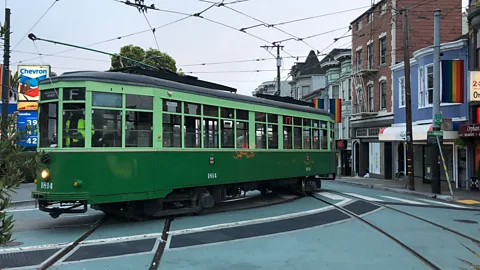 Laura Kiniry
Laura Kiniry4. Best for a vintage trip: San Francisco street cars
Not to be mistaken for the city's iconic cable cars, San Francisco's colourfully painted vintage street cars have been rumbling along the city's central Market Street corridor since 1995 and along the Embarcadero to Fisherman's Wharf since 2000. These restored late 19th- to early 20th-Century streamlined beauties – many of them brought in from Philadelphia and then refurbished in historically accurate paint schemes, showing how they would have been originally painted in, say, Osaka or Melbourne – are a throwback to an era when electric street cars proliferated. Riding in one is almost like stepping back in time. Their history is on full display at the San Francisco Railway Museum & Gift Shop, where archival photography and rare motion picture footage provide a sense of what SF was like in its own streetcar heyday.
Getting around
There's no reason to rent a car in San Francisco. Your two feet and public transport can get you almost everywhere. The city is compact and features easy-to-access bikeshare programmes, Bay Area Rapid Transit (BART), Muni metro and cable car transportation systems. Plus, finding a parking spot in many neighbourhoods is more trouble than it's worth.
Unlike cable cars, which are pulled up San Francisco's steep hills by underground cables, the street cars making up SF's historic F line get their power from overhead wires. Trying to identify them by their colours and numbers is a game that San Franciscans love playing. For example, the No 1070 Newark, NJ is easily recognisable due to its bright-red wheels; while the vibrant yellow of the No 1057 Cincinnati, OH is an Instagram favourite. There's also the boxier "Peter Witt" streetcars, equipped with wooden-slat bench seats and exteriors sporting the green, orange, and yellow-and-white liveries of those that once operated (and some that still do) in Milan, Italy.
On warmer days and special occasions, the F line even rolls out two open-top "boat trams" from Blackpool, England. While the coloured lights strewn along their masts are a tribute to Blackpool's own autumn Illuminations tradition, their "Jolly Roger" flags are an ode to San Francisco's freewheeling spirit.
Website: www.streetcar.org/museum/
Address: 77 Steuart Street, San Francisco
Phone: +1 415-974-1948
Instagram: @sfmta_muni
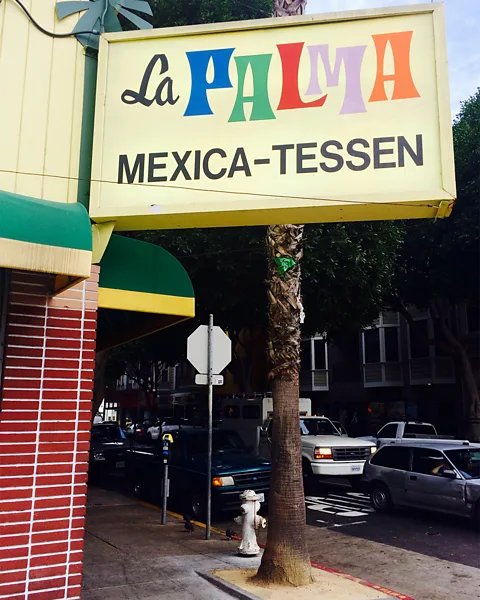 Laura Kiniry
Laura Kiniry5. Best for sensory overload: Calle 24 Latino Cultural District
San Francisco's Outer Mission District has been a Latinx neighbourhood since the early 1940s, when it started attracting immigrants from Mexico, followed by Chileans, Salvadorans, Guatemalans, Puerto Ricans and other Central and South American countries. Today, the cultural melting pot that comprises San Francisco's larger Mission neighbourhood can often feel lost among its swanky bars and boutiques. But despite the area's ongoing gentrification, 24th Street between Mission Street and Potrero Avenue holds tight to its distinct heritage.
Walk it out
Locally run Foodie Adventures hosts excellent 3.5-hour walking tours along 24th Street, focusing on many of the area's best authentic Latinx spots.
This is what's known as the Calle 24 Latino Cultural District, where hole-in-the-wall taquerias still serve up mouth-watering carnitas (shredded pork) tacos; prayer candles, piñatas and lucha libre wrestling masks stock the shelves; and bakeries whip up loaves of pan dulce and chocolate concha pastries daily.
Whether it's shopping for molcajetes (mortar and pestles) and handmade tortillas at the 70-plus-year-old La Palma Mexicatessen, catching a performance by Salvadoran American dancer/choreographer Jessica Recinos and her Rising Rhythm Dance Company at the renovated 1920s Brava Theater Center or simply strolling among the many political and thought-provoking murals along Balmy Alley, you'll find it here in the beating heart of San Francisco's Latinx heritage.
Website: www.calle24sf.org/
Address: 3250 24th Street, San Francisco
Phone: +1 415 658 7930
Instagram: @calle24_sf
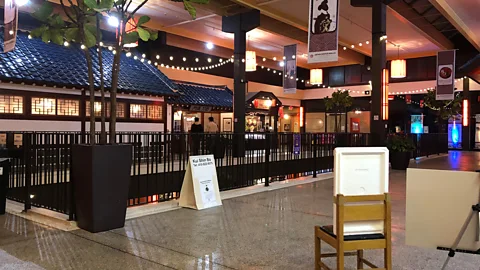 Laura Kiniry
Laura Kiniry6. Best for culture: Japantown
Unlike San Francisco's Chinatown, with its stunning pagoda roofs, the city's Japantown isn't as architecturally eye-catching, but this understated neighbourhood offers a glimpse into a part of San Francisco's history that's often overlooked.
The oldest and largest Japanese community in the US, SF's Japantown originated after the city's devastating 1906 earthquake and fire, when displaced Japanese residents living in the South of Market area and on the outskirts of Chinatown began moving west. During World War Two, the US government forced Japanese Americans from their homes and into internment camps, leaving much of the neighbourhood vacant. Despite hardships, including a fight against urban renewal, Japantown prevailed.
Insider tips
The non-profit San Francisco City Guides occasionally hosts free Japantown walking tours. The US' second-largest cherry blossom festival- also occurs here over two weekends each April.
Today, you can sit down to fresh noodles made onsite at Udon Mugizo; take beginner origami classes or shop for decorative papers in prints like tie-dye and Japanese garden at Paper Tree, and croon to your heart's content at Pagoda, where group sing-a-longs are the norm.
Other popular stops include Kabuki Springs & Spa, a neighbourhood landmark known for its shiatsu massage and soaking tubs, and Nijiya Market, where you can pick up a freshly made seafood bento box or sushi bowl to enjoy within the Japantown Peace Plaza – an outdoor space between the area's two Japan Center Malls, dominated by the five-tiered Peace Pagoda.
Website: www.sfjapantown.org/
Instagram: @sf_japantown
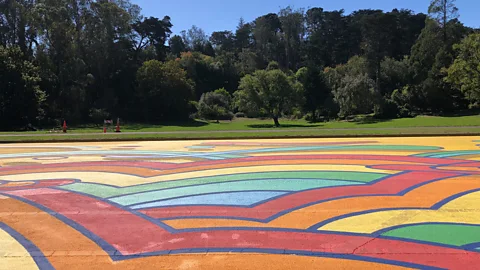 Laura Kiniry
Laura Kiniry7. Best for an outdoor adventure: JFK Promenade
Although a portion of Golden Gate Park's main thoroughfare has been closed to vehicular traffic on Sundays and holidays for more than 50 years, JFK Promenade, a 1.5-mile stretch between Stanyan Street and Crossover Drive, became a haven for city residents during the pandemic, when the city kept it closed each day so cyclists, pedestrians, roller skaters and skateboarders could enjoy some fresh air. The move became permanent in 2022, when the street was reborn as JFK Promenade. It's now one of the best outdoor spaces to congregate in the city.
In September 2022, the city arts non-profit Illuminate simultaneously launched the Golden Mile Project, an ongoing transformation of the promenade into a gathering space of art and performance. SF non-profit Paint the Void led the installation of 12 colourful murals painted upon the road, which these days also features inventive artworks like a humpback whale tail, a series of bronze Dogman and Rabbitwoman sculptures showcasing these more-than-8ft-tall anamorphic figures in scenes from everyday life, and small parklets brimming with playable pianos, ping pong tables and corn hole sets, and movable Adirondack chairs.
Listen to live music in an occasional pop-up beer garden near 14th Avenue, or climb onto giant letter blocks that spell out "LOVE" just east of the Conservatory of Flowers – a Victorian-style glass-and-wood greenhouse where exotic plants such as climbing oleander and Thai Pink Aeschynanthus thrive.
Website: https://sfrecpark.org/1538/JFK-Promenade
Instagram: @goldenmileart
BBC Travel's The SpeciaList is a series of guides to popular and emerging destinations around the world, as seen through the eyes of local experts and tastemakers.
---
Join more than three million BBC Travel fans by liking us on Facebook, or follow us on Twitter and Instagram.
If you liked this story, sign up for the weekly bbc.com features newsletter called ”The Essential List”. A handpicked selection of stories from BBC Future, Culture, Worklife and Travel, delivered to your inbox every Friday.
